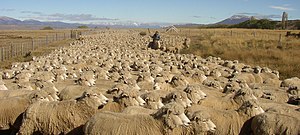
Sheep meat is one of the most common meats around the world, taken from the domestic sheep, Ovis aries, and generally divided into lamb, from sheep in their first year, hogget, from sheep in their second, and mutton from older sheep. Generally, "hogget" and "sheep meat" are not used by consumers outside Norway, New Zealand, South Africa, Scotland, and Australia. Hogget has become more common in England, particularly in the North often in association with rare breed and organic farming.

The Merino is a breed or group of breeds of domestic sheep, characterised by very fine soft wool. It was established in Spain near the end of the Middle Ages, and was for several centuries kept as a strict Spanish monopoly; exports of the breed were not allowed, and those who tried risked capital punishment. During the eighteenth century, flocks were sent to the courts of a number of European countries, including France, Hungary, the Netherlands, Prussia, Saxony and Sweden. The Merino subsequently spread to many parts of the world, including South Africa, Australia, and New Zealand. Numerous recognised breeds, strains and variants have developed from the original type; these include, among others, the American Merino and Delaine Merino in the Americas, the Australian Merino, Booroola Merino and Peppin Merino in Oceania, and the Gentile di Puglia, Merinolandschaf and Rambouillet in Europe.
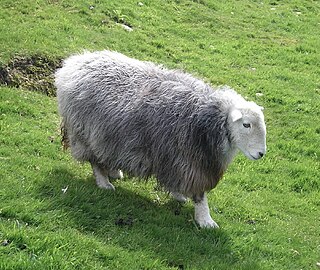
The Herdwick is a breed of domestic sheep native to the Lake District in North West England. The name "Herdwick" is derived from the Old Norse herdvyck, meaning sheep pasture. Though low in lambing capacity and perceived wool quality when compared to more common commercial breeds, Herdwicks are prized for their robust health, their ability to live solely on forage, and their tendency to be territorial and not to stray over the difficult upland terrain of the Lake District. It is considered that up to 99% of all Herdwick sheep are commercially farmed in the central and western Lake District.
Mulesing is the removal of strips of wool-bearing skin from around the breech (buttocks) of a sheep to prevent the parasitic infection flystrike (myiasis). The wool around the buttocks can retain feces and urine, which attracts flies. The scar tissue that grows over the wound does not grow wool, so is less likely to attract the flies that cause flystrike. Mulesing is a common practice in Australia for this purpose, particularly on highly wrinkled Merino sheep. Mulesing is considered by some to be a skilled surgical task. Mulesing can only affect flystrike on the area cut out and has no effect on flystrike on any other part of the animal's body.
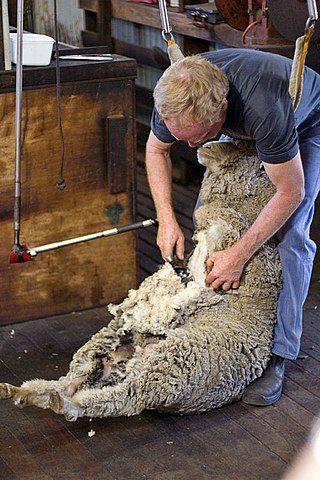
Sheep shearing is the process by which the woollen fleece of a sheep is cut off. The person who removes the sheep's wool is called a shearer. Typically each adult sheep is shorn once each year. The annual shearing most often occurs in a shearing shed, a facility especially designed to process often hundreds and sometimes more than 3,000 sheep per day.

Crutching refers to the removal of wool from around the tail and between the rear legs of a sheep for hygiene purposes. It can also refer to removing wool from the heads of sheep. It does not refer to the process of mulesing—a controversial procedure that involves removing of strips of wool-bearing skin from around the breech (buttocks) of a sheep.

The Border Leicester is a British breed of sheep. It is a polled, long-wool sheep and is considered a dual-purpose breed as it is reared both for meat and for wool. The sheep are large but docile. They have been exported to other sheep-producing regions, including Australia and the United States.
Lamb marking is the term applied to the procedure of earmarking, castration and tail-docking of the lambs of domestic sheep. Vaccination is usually carried out then, too. Sheep are usually ear marked at approximately 3 months of age after lambing (birth). Lambs are castrated to prevent full development of reproductive organs and hormones. Ear marking is used to identify each lamb in the flock and tail-docking is usually carried out to prevent blowfly strike. At some stage, blow-flies lay their eggs within moist and warm areas of the sheep. Then, the maggots grow and eat away the live flesh of the sheep. This causes great distress and pain for the lamb. Sometimes lambs are also mulesed. This is also carried out for the same reason.

The Romney, formerly called the Romney Marsh sheep but generally referred to by the local farmers as the Kent, is a breed of sheep originating in England. The Romney is a "long-wool" breed recognized in England by 1800. Exported to other continents, the Romney is an economically important sheep breed, especially to the sheep-meat and wool export trades of New Zealand.
The Finnish Landrace, Finn or Finnsheep is a breed of domestic sheep native to Finland. It is one of several Northern European short-tailed sheep breeds, but is notable for its high incidence of multiple births – it is common for a ewe to have three, four, or even five lambs at once.

The raising of domestic sheep has occurred in nearly every inhabited part of the globe, and the variations in cultures and languages which have kept sheep has produced a vast lexicon of unique terminology used to describe sheep husbandry.
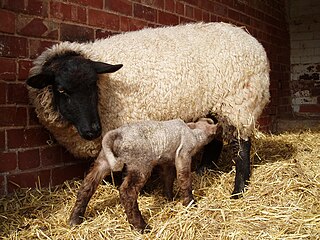
Domestic sheep reproduce sexually much like other mammals, and their reproductive strategy is furthermore very similar to other domestic herd animals. A flock of sheep is generally mated by a single ram, which has either been chosen by a farmer or has established dominance through physical contest with other rams. Most sheep have a breeding season (tupping) in the autumn, though some are able to breed year-round.

Sheep or domestic sheep are a domesticated, ruminant mammal typically kept as livestock. Although the term sheep can apply to other species in the genus Ovis, in everyday usage it almost always refers to domesticated sheep. Like all ruminants, sheep are members of the order Artiodactyla, the even-toed ungulates. Numbering a little over one billion, domestic sheep are also the most numerous species of sheep. An adult female is referred to as a ewe, an intact male as a ram, occasionally a tup, a castrated male as a wether, and a young sheep as a lamb.

Lucilia cuprina, formerly named Phaenicia cuprina, the Australian sheep blowfly is a blow fly in the family Calliphoridae. It causes the condition known as "sheep strike"'. The female fly locates a sheep with ideal conditions, such as an open wound or a build-up of faeces or urine in the wool, in which she lays her eggs. The emerging larvae cause large lesions on the sheep, which may prove to be fatal.

The Wiltipoll is a breed of polled domestic sheep that was developed in Australia from Wiltshire Horn sheep with the infusion of Border Leicester, Perendale, Poll Dorset, and Poll Merino genetics, that are raised for meat.

The history of the domestic sheep goes back to between 11,000 and 9,000 BC, and the domestication of the wild mouflon in ancient Mesopotamia. Sheep are among the first animals to have been domesticated by humans. These sheep were primarily raised for meat, milk, and skins. Woolly sheep began to be developed around 6000 BC. They were then imported to Africa and Europe via trading.
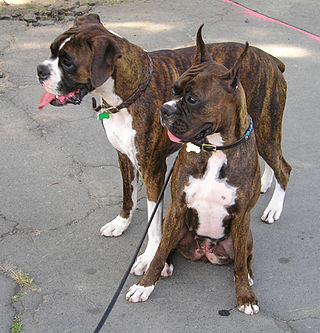
Numerous procedures performed on domestic animals are usually more invasive than purely cosmetic alterations, but differ from types of veterinary surgery that are performed exclusively for urgent health reasons. Such procedures have been grouped together under the technical term 'mutilatory' by the Royal College of Veterinary Surgeons in a report describing the reasons for their being conducted and their welfare consequences, and by others.
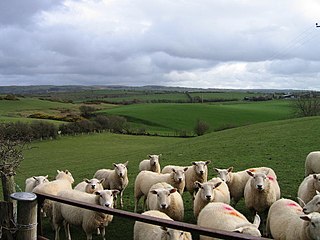
Sheep farming has been important to the economy of Wales. Much of Wales is rural countryside and sheep are seen throughout the country. The woollen industry in Wales was a major contributor to the national economy, accounting for two-thirds of the nation's exports in 1660. Sheep farms are most often situated in the country's mountains and moorlands, where sheepdogs are employed to round up flocks. Sheep are also reared, however, along the south and west coasts of Wales. In 2017 there were more than 10 million sheep in Wales and the total flock made up nearly 33% of the British total. In 2011 sheep farming accounted for 20% of agriculture in Wales.

Goat farming involves the raising and breeding of domestic goats as a branch of animal husbandry. People farm goats principally for their meat, milk, fibre and skins.

Sheep farming in Azerbaijan is directed to the production of meat, fiber (wool) and dairy products. It is considered as an old animal husbandry branch and usual for around the country. Production in variety fields such as wool, meat and dairy products makes sheep farming leading animal husbandry field in the country. There are few pasture areas in Azerbaijan and it shows negative impact on the productivity of the sheep breeding.
